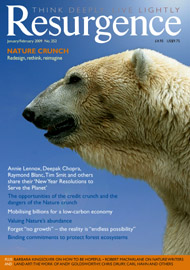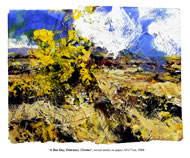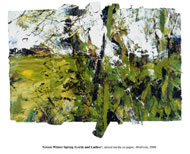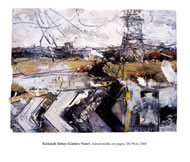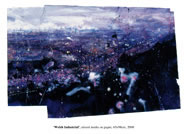DAVID TRESS’S RECENT painting A Hot Day, February (Tretio) is a fine example of his work. It is a painting of a place experienced under particular conditions of light and weather at a certain time, but well known to the artist from many visits over the years. The landscape has a sensuous immediacy, but, rather than being a fleeting impression, it is immensely earthy: a place forged by natural forces and charged with a sense of geological and historical time.
Looking at the painting, one sees first a blaze of yellow – an image which conveys not just the appearance of gorse, but an impression of its flaming energy. This blends with the quieter movement of white clouds. The gorse flares in a swirl of colour out of the subdued ochre and yellow and brown of the rocky, uneven ground. All in the foreground is intensely alive, a fluid, dynamic movement, but belonging to an Earth marked by ancient human presence. As one’s gaze settles so it comes to rest on distance – a line of silvery-blue hills blending with blue sky. Now the whole image combines energy with depth. This Pembrokeshire landscape, experienced at this moment of time, is a palimpsest, an intensely living place layered with the past.
The wonderful freshness and vigour, combined with a sense of the ancient and enduring, is characteristic of Tress’s personal vision. He would echo, I think, John Constable’s “Painting is with me but another word for feeling,” where feeling is for both artistic medium and subject. “Art”, says Peter Abbs, “involves a sensuous embodiment. It is an intensely physical activity – an erotic activity – working towards the spirit, towards value.” The implication, as we see with Tress, is that his whole person is involved in the act of painting. The viewer is consequently awakened to the life in things, and experiences landscapes infused with spirit.
Tress was born in London in 1955, and has lived in West Wales since 1976. He studied Fine Art at Trent Polytechnic, and learnt from aspects of abstract expressionism, especially its use of dynamic gestures, and the sense of the painting as an action. He learnt also from the detailed precision of Pre-Raphaelite painting. Having absorbed the lessons, he moved on, arriving at his mature vision by a process of experimentation. This involved both development of his techniques as an artist using watercolour and other media, and participation in a landscape – immersion in it, in all weathers and seasons:intimate knowledge of his subjects, gained over a period of time.
Tress’s originality springs from his relationship to the tradition of British landscape painting. John Piper, in British Romantic Artists, wrote, “Romantic art deals with the particular.” This is true of Tress. His paintings at their most fluid and dynamic never dissolve the image; they record an encounter between inner and outer, the painter and some aspect of the external world.
Piper also emphasised that the tradition of British landscape painting, established by Thomas Girtin and J. M. W. Turner, shared with the Romantic poets its impulse to reveal the universal through the particular. “They wanted to make landscape a means of reporting and recording, not places and things, but life.” In the 1940s, the neo-Romantic painters, such as Paul Nash and Graham Sutherland, with whom Tress feels an affinity, had a similar sense of the ‘poetic’. Far from meaning anything nebulous, this refers to embodied vision. It refers, for example, to Paul Nash’s feeling for charged landscapes, for ‘spirit of place’ in ancient chalklands, and to Graham Sutherland’s sense of ‘presence’ in the landscape. Later painters whom Tress admires include Peter Lanyon and, especially, Joan Eardley in her paintings of the north-east Scottish coast and sea at Catterline. Like Tress himself, all these are highly individual painters. What they have in common is a mastery of pictorial images of landscape and the natural world that embody elemental and spiritual power. They record the experience of life.
TRESS’S PEMBROKESHIRE landscapes bear the imprint of thousands of years of human connection. They are sacred landscapes marked by Neolithic burial mounds and medieval pilgrim routes. In his depiction of the relationship between the aerial and the earthbound Tress is sensitive to what Wordsworth found at Grasmere: “A blended holiness of Earth and sky”. He responds keenly to what a later poet, R. S. Thomas, found in Wales: both a history of conflict (“the spilled blood | That went to the making of the wild sky”), and sacred mystery (“the miracle of the lit bush”).
Tress’s paintings evoke strong feelings. In a recent sequence of three paintings, Green Winter Spring, for example, the fluid interaction of green and yellow and black in the foreground vegetation, against glimpses of blue hills and sky, produces a sense of awakening. This has the chill freshness of early spring, together with a new seeing of the near and far, the ‘opening’, which is accompanied by a vibration in all the senses, as one sees and feels the world anew. The excitement includes an element of raw discomfort, and is at once spiritual and sexual. Tress is equally capable of capturing the truth of an urban scene, as in his Welsh Industrial, where one can virtually taste the dust in the atmosphere and feel as physical sensation the relationship between indrawn valley terraces and distant view.
IN HIS CURRENT travelling exhibition, Chasing Sublime Light, Tress pays homage to the beginnings of the British landscape painting tradition to which he belongs. In responding to landscapes painted more than 200 years ago by painters such as Thomas Girtin and Turner, however, he is not copying their views. To do so would be false to the tradition itself, to its achievement of personal visions, well summed up by Thomas Hardy’s description of Turner’s late watercolours as “a landscape plus a man’s soul”. History, too, is implicated in perception of landscape, as we see in Turner’s Rain, Steam and Speed (1844), in which the artist has painted, not merely a train crossing a viaduct, but the experience of the new age.
Similarly, Tress’s Kirkstall Abbey (Girtin’s View) is not a copy of what Girtin saw in the 1790s, but an experience of the scene now. In Girtin’s serene view the abbey is at one with a natural order, sharing a sense of religious harmony with river, cattle and trees, and the human figures on the riverbank. In Tress’s painting from the same viewpoint, all is jagged, disturbed, and vibrant with different energies stemming from road and railway, and the electricity pylon which now dominates the landscape as the abbey formerly did.
This is a depiction of the place experienced now, fraught with potent and dangerous forces. This too is a palimpsest, although in this landscape the different layers create a powerful dissonance. Here, as in his Pembrokeshire landscapes, Tress paints the truth of experience. •




